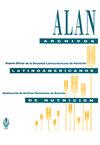Estado nutricional y preferencia del sabor dulce en adultos chilenos
IF 0.3
4区 医学
Q4 NUTRITION & DIETETICS
引用次数: 0
Abstract
El dramatico aumento de la prevalencia e incidencia de la obesidad sugiere que factores ambientales y cambios en el estilo de vida contribuyen de forma importante a su tendencia epidemica. En humanos, se han reportado diferencias interindividuales en los umbrales de deteccion y preferencia del sabor dulce, lo que podria afectar la ingesta habitual de azucares, y por ende al estado nutricional. Objetivo: El presente estudio busca determinar la relacion entre el estado nutricional y la preferencia al sabor dulce en la comunidad de un establecimiento de educacion superior. Metodo: Muestra fue constituida por estudiantes, funcionarios y docentes, entre 18 y 60 anos, pertenecientes a la Universidad Mayor, Sede Temuco. Para determinar preferencia al sabor dulce se empleo prueba organoleptica que mide grado de satisfaccion frente a solucion dulce, junto a ello se realizaron mediciones de peso y talla para determinar el Indice de Masa Corporal. Resultados: Muestra final comprendio de 319 personas, de las cuales un 30,1% fueron hombres y 69,9% mujeres. No se observaron diferencias significativas en la preferencia hacia las soluciones con mayor concentracion de sacarosa segun el estado nutricional. Sin embargo, el modelo predictivo desarrollado arrojo que hombres prefieren las soluciones con mayor concentracion de azucar independiente de la edad y estado nutricional. Conclusiones: Es necesario desarrollar nuevos estudios que permitan aclarar si la preferencia al sabor dulce favorece el desarrollo de obesidad y sobrepeso, o si es la composicion nutricional de los alimentos procesados o ultraprocesados, lo que esta teniendo un mayor impacto negativo en el estado nutricional de la poblacion. The dramatic increase in the prevalence and incidence of obesity seems to suggest that environmental factors and lifestyle changes are contributing significantly to the epidemic trend of this pathology. In humans, inter-individual differences in the thresholds of preference of sweet taste have been reported, which could affect habitual sugar intake, and therefore the nutritional status. Objective: The present study seeks to determine the relationship between nutritional status and the preference of sweet taste in the population of a higher education establishment. Method: Sample was constituted by students, officials and teachers between 18 and 60 years, belonging to the Universidad Mayor, Temuco. To determine the perception of the sweet taste, an organoleptic test was used that measures the degree of satisfaction with the sweet solution, along with this, weight and height measurements were made to determine the Body Mass Index. Results: Final sample comprised 319 people, of which 30.1% were men and 69.9% women. No significant differences were observed in the preference for solutions with a higher concentration of sucrose according to nutritional status. However, a predictive model developed showed that men prefer the solutions with the highest concentration of sugar regardless of age and nutritional status. Conclusions: It is necessary to develop new studies to clarify whether the preference for sweet taste favors the development of obesity and overweight, or if it is the nutritional composition of processed or ultraprocessed foods, which is having a greater negative impact on the nutritional status of the population.智利成年人的营养状况和甜味偏好
肥胖患病率和发病率的急剧增加表明,环境因素和生活方式的改变是其流行趋势的重要因素。在人类中,有报道称个体间对甜味的检测阈值和偏好存在差异,这可能会影响通常的糖摄入量,从而影响营养状况。摘要目的:探讨高等教育机构社区营养状况与甜味偏好之间的关系。方法:样本由18 - 60岁的学生、工作人员和教师组成,属于特穆科市长大学。为了确定对甜味的偏好,我们使用感官测试来测量对甜味溶液的满意程度,同时测量体重和身高来确定身体质量指数。结果:最终样本319人,其中男性30.1%,女性69.9%。营养状况对蔗糖浓度较高的溶液的偏好无显著差异。然而,所开发的预测模型表明,无论年龄和营养状况如何,男性都更喜欢含糖量较高的溶液。结论:需要开发新研究,以澄清如果偏好口味甜宠爱发展肥胖和超重,或者如果是composicion加工食品或ultraprocesados营养,你将要有更大影响到人口的营养状况。肥胖流行率和发病率的急剧增加似乎表明,环境因素和生活方式的改变是这种疾病流行趋势的重要促成因素。在人类中,对甜味偏好阈值的个体间差异已被报道,这可能会影响通常的糖摄入量,从而影响营养状况。目的:本研究旨在确定高等教育机构人群的营养状况与甜味偏好之间的关系。方法:样本由18至60岁的学生、官员和教师组成,属于特穆科市长大学。为了确定对甜味的感知,使用了一种感官测试来测量对甜味溶液的满足程度,同时还进行了体重和高度测量来确定身体质量指数。结果:最终样本包括319人,其中30.1%为男性,69.9%为女性。根据营养状况,人们对蔗糖浓度较高的溶液的偏好没有显著差异。然而,一个预测模型表明,无论年龄和营养状况如何,男性都更喜欢糖浓度最高的溶液。结论:需要开展新的研究来澄清对甜味的偏好是否有利于肥胖和超重的发展,还是加工食品或超加工食品的营养成分对人口的营养状况有更大的负面影响。
本文章由计算机程序翻译,如有差异,请以英文原文为准。
求助全文
约1分钟内获得全文
求助全文
来源期刊
CiteScore
0.50
自引率
0.00%
发文量
31
期刊介绍:
Archivos Latinoamericanos de Nutrición (ALAN) is the official publication of the Sociedad Latinoamericana de Nutición (SLAN), for the dissemination of knowledge in the fields of food and nutrition, principally throughout the American Hemisphere. Articles in Spanish, English, Portuguese and French are accepted, both from the Society members and from nonmembers, in the following categories: 1. General articles (critical scientific reviews); 2. Research articles (originals); 3. Papers in applied nutrition (analytical results from intervention programs and discussion of reconmendations of practical application), and 4. Letters to Editor (short comments of general interest or about scientific facts and results previously published in Archives).

 求助内容:
求助内容: 应助结果提醒方式:
应助结果提醒方式:


